Shengxi Li
Continuous Patch Stitching for Block-wise Image Compression
Feb 24, 2025Abstract:Most recently, learned image compression methods have outpaced traditional hand-crafted standard codecs. However, their inference typically requires to input the whole image at the cost of heavy computing resources, especially for high-resolution image compression; otherwise, the block artefact can exist when compressed by blocks within existing learned image compression methods. To address this issue, we propose a novel continuous patch stitching (CPS) framework for block-wise image compression that is able to achieve seamlessly patch stitching and mathematically eliminate block artefact, thus capable of significantly reducing the required computing resources when compressing images. More specifically, the proposed CPS framework is achieved by padding-free operations throughout, with a newly established parallel overlapping stitching strategy to provide a general upper bound for ensuring the continuity. Upon this, we further propose functional residual blocks with even-sized kernels to achieve down-sampling and up-sampling, together with bottleneck residual blocks retaining feature size to increase network depth. Experimental results demonstrate that our CPS framework achieves the state-of-the-art performance against existing baselines, whilst requiring less than half of computing resources of existing models. Our code shall be released upon acceptance.
Hierarchical Semantic Compression for Consistent Image Semantic Restoration
Feb 24, 2025Abstract:The emerging semantic compression has been receiving increasing research efforts most recently, capable of achieving high fidelity restoration during compression, even at extremely low bitrates. However, existing semantic compression methods typically combine standard pipelines with either pre-defined or high-dimensional semantics, thus suffering from deficiency in compression. To address this issue, we propose a novel hierarchical semantic compression (HSC) framework that purely operates within intrinsic semantic spaces from generative models, which is able to achieve efficient compression for consistent semantic restoration. More specifically, we first analyse the entropy models for the semantic compression, which motivates us to employ a hierarchical architecture based on a newly developed general inversion encoder. Then, we propose the feature compression network (FCN) and semantic compression network (SCN), such that the middle-level semantic feature and core semantics are hierarchically compressed to restore both accuracy and consistency of image semantics, via an entropy model progressively shared by channel-wise context. Experimental results demonstrate that the proposed HSC framework achieves the state-of-the-art performance on subjective quality and consistency for human vision, together with superior performances on machine vision tasks given compressed bitstreams. This essentially coincides with human visual system in understanding images, thus providing a new framework for future image/video compression paradigms. Our code shall be released upon acceptance.
InstructOCR: Instruction Boosting Scene Text Spotting
Dec 20, 2024Abstract:In the field of scene text spotting, previous OCR methods primarily relied on image encoders and pre-trained text information, but they often overlooked the advantages of incorporating human language instructions. To address this gap, we propose InstructOCR, an innovative instruction-based scene text spotting model that leverages human language instructions to enhance the understanding of text within images. Our framework employs both text and image encoders during training and inference, along with instructions meticulously designed based on text attributes. This approach enables the model to interpret text more accurately and flexibly. Extensive experiments demonstrate the effectiveness of our model and we achieve state-of-the-art results on widely used benchmarks. Furthermore, the proposed framework can be seamlessly applied to scene text VQA tasks. By leveraging instruction strategies during pre-training, the performance on downstream VQA tasks can be significantly improved, with a 2.6% increase on the TextVQA dataset and a 2.1% increase on the ST-VQA dataset. These experimental results provide insights into the benefits of incorporating human language instructions for OCR-related tasks.
Causal Context Adjustment Loss for Learned Image Compression
Oct 07, 2024



Abstract:In recent years, learned image compression (LIC) technologies have surpassed conventional methods notably in terms of rate-distortion (RD) performance. Most present learned techniques are VAE-based with an autoregressive entropy model, which obviously promotes the RD performance by utilizing the decoded causal context. However, extant methods are highly dependent on the fixed hand-crafted causal context. The question of how to guide the auto-encoder to generate a more effective causal context benefit for the autoregressive entropy models is worth exploring. In this paper, we make the first attempt in investigating the way to explicitly adjust the causal context with our proposed Causal Context Adjustment loss (CCA-loss). By imposing the CCA-loss, we enable the neural network to spontaneously adjust important information into the early stage of the autoregressive entropy model. Furthermore, as transformer technology develops remarkably, variants of which have been adopted by many state-of-the-art (SOTA) LIC techniques. The existing computing devices have not adapted the calculation of the attention mechanism well, which leads to a burden on computation quantity and inference latency. To overcome it, we establish a convolutional neural network (CNN) image compression model and adopt the unevenly channel-wise grouped strategy for high efficiency. Ultimately, the proposed CNN-based LIC network trained with our Causal Context Adjustment loss attains a great trade-off between inference latency and rate-distortion performance.
QVD: Post-training Quantization for Video Diffusion Models
Jul 16, 2024Abstract:Recently, video diffusion models (VDMs) have garnered significant attention due to their notable advancements in generating coherent and realistic video content. However, processing multiple frame features concurrently, coupled with the considerable model size, results in high latency and extensive memory consumption, hindering their broader application. Post-training quantization (PTQ) is an effective technique to reduce memory footprint and improve computational efficiency. Unlike image diffusion, we observe that the temporal features, which are integrated into all frame features, exhibit pronounced skewness. Furthermore, we investigate significant inter-channel disparities and asymmetries in the activation of video diffusion models, resulting in low coverage of quantization levels by individual channels and increasing the challenge of quantization. To address these issues, we introduce the first PTQ strategy tailored for video diffusion models, dubbed QVD. Specifically, we propose the High Temporal Discriminability Quantization (HTDQ) method, designed for temporal features, which retains the high discriminability of quantized features, providing precise temporal guidance for all video frames. In addition, we present the Scattered Channel Range Integration (SCRI) method which aims to improve the coverage of quantization levels across individual channels. Experimental validations across various models, datasets, and bit-width settings demonstrate the effectiveness of our QVD in terms of diverse metrics. In particular, we achieve near-lossless performance degradation on W8A8, outperforming the current methods by 205.12 in FVD.
Blind Super-Resolution via Meta-learning and Markov Chain Monte Carlo Simulation
Jun 13, 2024Abstract:Learning-based approaches have witnessed great successes in blind single image super-resolution (SISR) tasks, however, handcrafted kernel priors and learning based kernel priors are typically required. In this paper, we propose a Meta-learning and Markov Chain Monte Carlo (MCMC) based SISR approach to learn kernel priors from organized randomness. In concrete, a lightweight network is adopted as kernel generator, and is optimized via learning from the MCMC simulation on random Gaussian distributions. This procedure provides an approximation for the rational blur kernel, and introduces a network-level Langevin dynamics into SISR optimization processes, which contributes to preventing bad local optimal solutions for kernel estimation. Meanwhile, a meta-learning-based alternating optimization procedure is proposed to optimize the kernel generator and image restorer, respectively. In contrast to the conventional alternating minimization strategy, a meta-learning-based framework is applied to learn an adaptive optimization strategy, which is less-greedy and results in better convergence performance. These two procedures are iteratively processed in a plug-and-play fashion, for the first time, realizing a learning-based but plug-and-play blind SISR solution in unsupervised inference. Extensive simulations demonstrate the superior performance and generalization ability of the proposed approach when comparing with state-of-the-arts on synthesis and real-world datasets. The code is available at https://github.com/XYLGroup/MLMC.
A Dynamic Kernel Prior Model for Unsupervised Blind Image Super-Resolution
Apr 26, 2024



Abstract:Deep learning-based methods have achieved significant successes on solving the blind super-resolution (BSR) problem. However, most of them request supervised pre-training on labelled datasets. This paper proposes an unsupervised kernel estimation model, named dynamic kernel prior (DKP), to realize an unsupervised and pre-training-free learning-based algorithm for solving the BSR problem. DKP can adaptively learn dynamic kernel priors to realize real-time kernel estimation, and thereby enables superior HR image restoration performances. This is achieved by a Markov chain Monte Carlo sampling process on random kernel distributions. The learned kernel prior is then assigned to optimize a blur kernel estimation network, which entails a network-based Langevin dynamic optimization strategy. These two techniques ensure the accuracy of the kernel estimation. DKP can be easily used to replace the kernel estimation models in the existing methods, such as Double-DIP and FKP-DIP, or be added to the off-the-shelf image restoration model, such as diffusion model. In this paper, we incorporate our DKP model with DIP and diffusion model, referring to DIP-DKP and Diff-DKP, for validations. Extensive simulations on Gaussian and motion kernel scenarios demonstrate that the proposed DKP model can significantly improve the kernel estimation with comparable runtime and memory usage, leading to state-of-the-art BSR results. The code is available at https://github.com/XYLGroup/DKP.
Enhancing Quality of Compressed Images by Mitigating Enhancement Bias Towards Compression Domain
Mar 10, 2024Abstract:Existing quality enhancement methods for compressed images focus on aligning the enhancement domain with the raw domain to yield realistic images. However, these methods exhibit a pervasive enhancement bias towards the compression domain, inadvertently regarding it as more realistic than the raw domain. This bias makes enhanced images closely resemble their compressed counterparts, thus degrading their perceptual quality. In this paper, we propose a simple yet effective method to mitigate this bias and enhance the quality of compressed images. Our method employs a conditional discriminator with the compressed image as a key condition, and then incorporates a domain-divergence regularization to actively distance the enhancement domain from the compression domain. Through this dual strategy, our method enables the discrimination against the compression domain, and brings the enhancement domain closer to the raw domain. Comprehensive quality evaluations confirm the superiority of our method over other state-of-the-art methods without incurring inference overheads.
Demystifying CNNs for Images by Matched Filters
Oct 16, 2022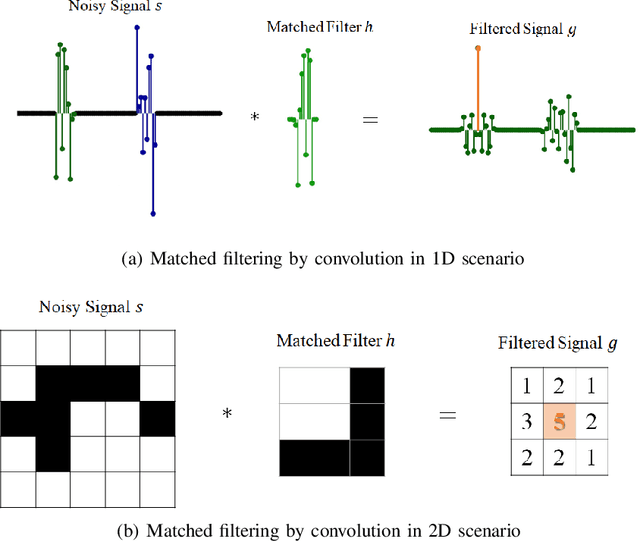
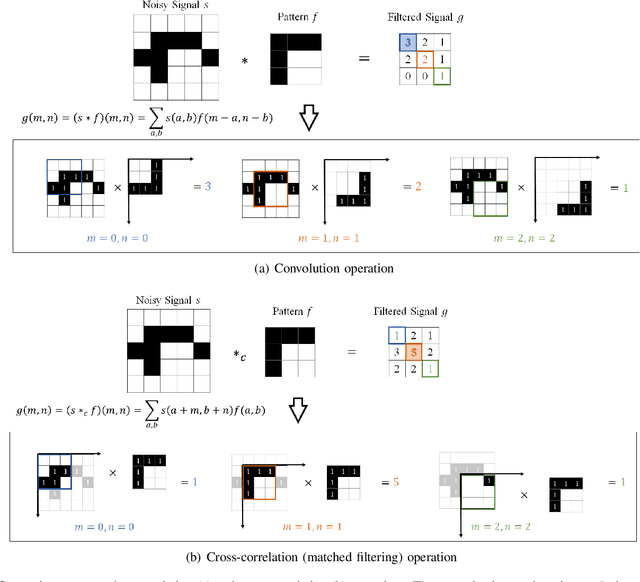


Abstract:The success of convolution neural networks (CNN) has been revolutionising the way we approach and use intelligent machines in the Big Data era. Despite success, CNNs have been consistently put under scrutiny owing to their \textit{black-box} nature, an \textit{ad hoc} manner of their construction, together with the lack of theoretical support and physical meanings of their operation. This has been prohibitive to both the quantitative and qualitative understanding of CNNs, and their application in more sensitive areas such as AI for health. We set out to address these issues, and in this way demystify the operation of CNNs, by employing the perspective of matched filtering. We first illuminate that the convolution operation, the very core of CNNs, represents a matched filter which aims to identify the presence of features in input data. This then serves as a vehicle to interpret the convolution-activation-pooling chain in CNNs under the theoretical umbrella of matched filtering, a common operation in signal processing. We further provide extensive examples and experiments to illustrate this connection, whereby the learning in CNNs is shown to also perform matched filtering, which further sheds light onto physical meaning of learnt parameters and layers. It is our hope that this material will provide new insights into the understanding, constructing and analysing of CNNs, as well as paving the way for developing new methods and architectures of CNNs.
Blind VQA on 360° Video via Progressively Learning from Pixels, Frames and Video
Nov 18, 2021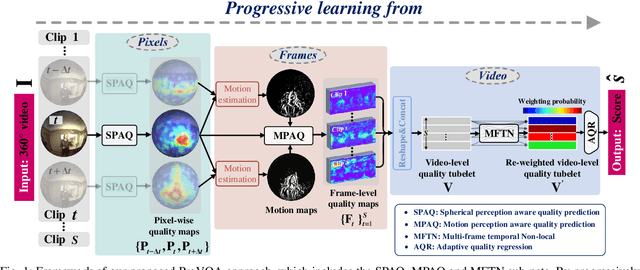
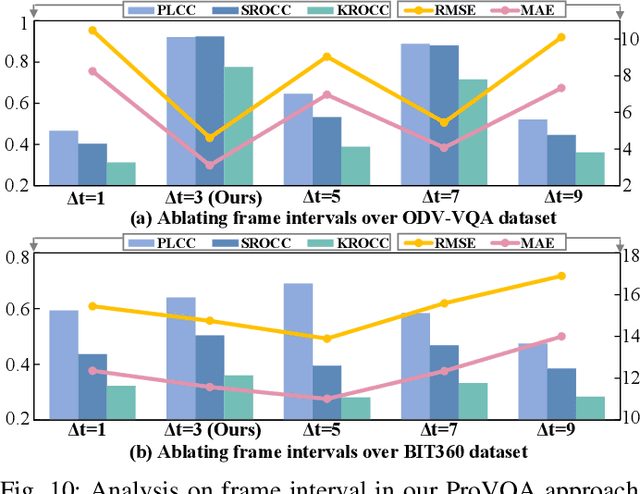
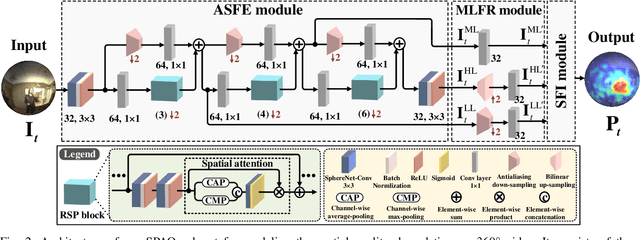

Abstract:Blind visual quality assessment (BVQA) on 360{\textdegree} video plays a key role in optimizing immersive multimedia systems. When assessing the quality of 360{\textdegree} video, human tends to perceive its quality degradation from the viewport-based spatial distortion of each spherical frame to motion artifact across adjacent frames, ending with the video-level quality score, i.e., a progressive quality assessment paradigm. However, the existing BVQA approaches for 360{\textdegree} video neglect this paradigm. In this paper, we take into account the progressive paradigm of human perception towards spherical video quality, and thus propose a novel BVQA approach (namely ProVQA) for 360{\textdegree} video via progressively learning from pixels, frames and video. Corresponding to the progressive learning of pixels, frames and video, three sub-nets are designed in our ProVQA approach, i.e., the spherical perception aware quality prediction (SPAQ), motion perception aware quality prediction (MPAQ) and multi-frame temporal non-local (MFTN) sub-nets. The SPAQ sub-net first models the spatial quality degradation based on spherical perception mechanism of human. Then, by exploiting motion cues across adjacent frames, the MPAQ sub-net properly incorporates motion contextual information for quality assessment on 360{\textdegree} video. Finally, the MFTN sub-net aggregates multi-frame quality degradation to yield the final quality score, via exploring long-term quality correlation from multiple frames. The experiments validate that our approach significantly advances the state-of-the-art BVQA performance on 360{\textdegree} video over two datasets, the code of which has been public in \url{https://github.com/yanglixiaoshen/ProVQA.}
 Add to Chrome
Add to Chrome Add to Firefox
Add to Firefox Add to Edge
Add to Edge